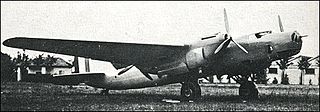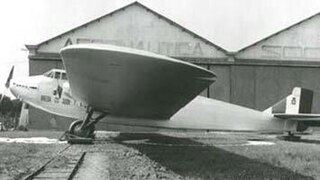
The Ambrosini SAI.207 was a light fighter interceptor built entirely from wood and developed in Italy during World War II. Powered by a single 750 hp Isotta Fraschini Delta, the SAI.207 enjoyed limited success during evaluation of the 12 pre-production aircraft.

The Fiat CR.20 was an Italian biplane fighter used during the 1920s and 1930s. Designed by Celestino Rosatelli, it represented an intermediate step from the early biplane CR.1 and the later, successful series CR.30, CR.32 and CR.42.

The Breda A.7 was a reconnaissance aircraft developed in Italy for use by the Regia Aeronautica in 1929. It was a braced parasol monoplane of conventional configuration with tailskid undercarriage. The pilot and observer sat in tandem, open cockpits. A single prototype of a long-range example, originally designated A.7 Raid and later A.16 was also constructed, but the air force showed no interest in it.

The Breda A.9 was a biplane trainer produced in Italy in 1928 for the Regia Aeronautica. Conventional in design, it featured a single-bay, unstaggered wing cellule and fixed tailskid undercarriage. The student and instructor sat in tandem, open cockpits. A slightly smaller version, designated A.9-bis was developed for use in Italy's aeroclubs.
The Breda Ba.15 was a two-seat light aircraft produced in Italy in 1928.

The Caproni Ca.135 was an Italian medium bomber designed in Bergamo in Italy by Cesare Pallavicino. It flew for the first time in 1935, and entered service with the Peruvian Air Force in 1937, and with the Regia Aeronautica in January 1938.

The Caproni Ca.165 was an Italian biplane fighter developed just before World War II, but produced only as a prototype, as the competing Fiat CR.42 Falco was selected for series production.

The Caproni Ca.100 was the standard trainer aircraft of the Regia Aeronautica in the 1930s. Large numbers of this tandem, two-seat, biplane were built, powered by different engines.

The Savoia-Marchetti SM.62 was an Italian single-engine maritime patrol flying boat produced from 1926. It served with the Regia Aeronautica and with a number of foreign users, and was licence-produced in Spain and the Soviet Union. Some of the Spanish aircraft were still in service during the Spanish Civil War
The Piaggio P.32 was an Italian medium bomber of the late 1930s, produced by Piaggio, and designed by Giovanni Pegna. It was a modern design for its time, but was a failure due to lack of powerplants commensurate with its high wing loading.

The Miles M.7 Nighthawk was a 1930s British training and communications monoplane designed by Miles Aircraft Limited.

The Savoia-Marchetti S.59 was a 1920s Italian reconnaissance/bomber flying boat designed and built by Savoia-Marchetti for the Regia Aeronautica.

The Caproni Vizzola F.4 was an Italian fighter aircraft prototype that was designed in 1937 and built from 1939. It was a single-seat, low-wing cantilever monoplane with retractable landing gear.
The Piaggio P.23M was an Italian commercial transport aircraft prototype designed and built by Piaggio.

The Piaggio P.50 was an Italian prototype heavy bomber designed and built by Piaggio for the Regia Aeronautica.

The Breda CC.20 was an Italian heavy bomber prototype of 1929 designed and built by the Breda company.

The twin-engined CANT Z.1011 was one of two bombers of about the same size and powered by the same engines, designed by Filippo Zappata in the mid-1930s. The other was the three-engined CANT Z.1007, which in the end was the type preferred by the Regia Aeronautica.

The Caproni Ca.95 was a large, three engine, long range, heavy bomber prototype built in Italy in 1929. It could carry a 1,600 kg (3,500 lb) bomb load and had three defensive gun positions. Only one was built.
The Macchi M.C.77 was a reconnaissance bomber flying boat built by Macchi in the thirties and remained at the prototype stage.
The Caproni Ca.146 was a high-wing reconnaissance aircraft built by Caproni in the mid-1930s.















